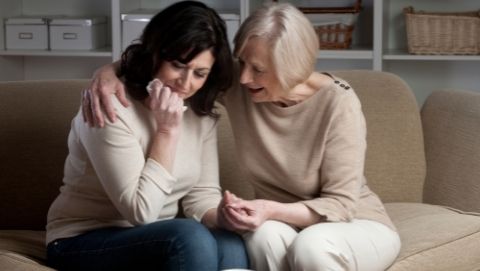Please give us feedback on one of our weekly question and answer articles. We value your time so the evaluation will only take 3 minutes or less, we promise!
Take the Survey »Grieving Together
By Kari Ure, Extension Assistant Professor
If you’ve ever listened to families talk about the past, you’ll know how views and memories of the same experience often differ from person to person. When a family experiences a loss, the grieving process also varies from member to member. It can be difficult to have patience with one another when it feels like the loss is the same, yet grieving the loss is different for each member of the family.
When grieving, a family member might not have the energy to recognize that others experience grief differently. This can create contention and cause the grieving family to drift apart during a time when they need each other’s support. Because the mourning process is so individual, family members might view each other as either not grieving or not grieving correctly.
Comments of concern, advice, and care can be misunderstood (Gilbert, 1996).
Making sense of the new family structure is part of grieving. Reconstructing the reality of life is a difficult process after a loss. It can be hard to know how to move on and find fulfillment in life without feeling guilty. Some feel finding joy in current life activities minimizes the memory and mourning for their loved one (Bartel, 2020).
A helpful practice for grieving families is to make a visual of the family story and recognize the changes to the story. The family should make a depiction of the family unit and roles prior to the loss. The depiction should then be reconstructed to show the loss of the family member, loss of the roles they fulfilled, and honor their contribution to the family unit. The reconstruction can include the family spiritual beliefs and honor how the family views death. This process can help members of the family feel a closeness to the deceased family member and to each other.
Discussion throughout this process can aid in healing (Brandon & Goldberg, 2017).
Remember that grief is as individual as reminsed memories. Family members should find ways they can honor their loved one together. This will take communication to find how each family member is comfortable honoring the loved one. Some family members may find comfort in already established family traditions, while other family members may want to keep those traditions as memories and establish new traditions. Relying on good communication, patience, and love, families can become stronger as they grieve together.
For more tips on family members working through grief together visit:https://www.urmc.rochester.edu/encyclopedia/content.aspx?contenttypeid=1&contentid=1746
References
- Bartel, B. T. (2020). Families grieving together: Integrating the loss of a child through ongoing relational connections. Death Studies, 44(8), 498–509.
- https://www-tandfonline-com.dist.lib.usu.edu/doi/full/10.1080/07481187.2019.158679
- Brandon, K. E., & Goldberg, R. M. (2017). A kinetic sculpture intervention for individuals grieving the deaths of family members. Journal of Creativity in Mental Health, 12(1), 99–114. https://doi-org.dist.lib.usu.edu/10.1080/15401383.2016.1184114
- Gilbert, K. R. (1996). `We’ve had the same loss, why don’t we have the same grief?’ Loss and differential grief in families. Death Studies, 20(3), 269.
- https://doi-org.dist.lib.usu.edu/10.1080/07481189608252781

